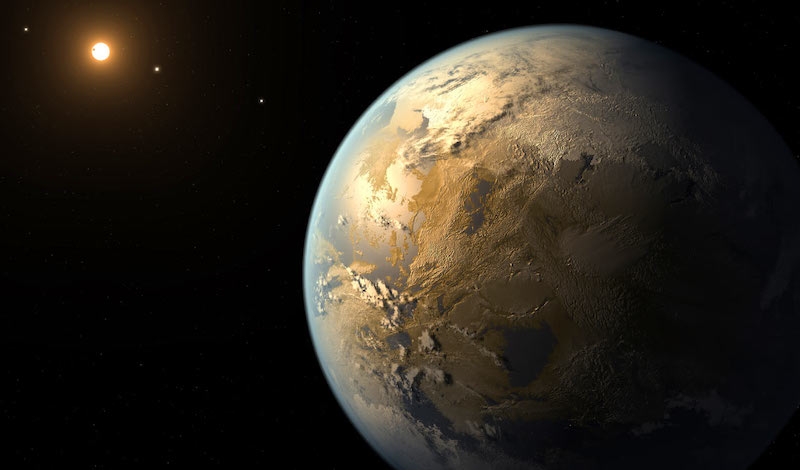
Astronomers have been discovering an increasing number of rocky exoplanets, worlds similar in size to Earth. This month (December 15, 2022), an international team of astronomers said it has found two more worlds in our own neighborhood of the galaxy. These worlds are less than 16 light-years away, very close, relatively speaking! And they’re in the habitable zone of their star, the zone within which liquid water can exist.
For comparison, Proxima Centauri b is the closest Earth-mass exoplanet, at 4.2 light-years away. It’s also similar in size to Earth and in its star’s habitable zone.
Researchers at the Institute of Astrophysics of the Canary Islands led the team that made the discovery. A new peer-reviewed paper has been accepted for publication by the journal Astronomy & Astrophysics.
2 potentially Earth-like worlds
The two new planets – GJ 1002b and GJ 1002c – orbit the red dwarf star GJ 1002, less than 16 light-years from Earth. That is very close in terms of stellar distances. Both planets have masses similar to Earth and orbit within the star’s habitable zone. That is the region around a star where temperatures could allow liquid water to exist on rocky planets. The discovery adds to previous findings showing that rocky worlds close in size and mass to Earth are quite common in our galaxy. Lead author Alejandro Suárez Mascareño at the Institute of Astrophysics of the Canary Islands stated:
Nature seems bent on showing us that Earth-like planets are very common. With these two we now know seven in planetary systems quite near to the sun.
GJ 1002b takes 10 days to orbit its star, while GJ 1002c takes just over 21 days.
The astronomers used the ESPRESSO (Echelle SPectrograph for Rocky Exoplanets and Stable Spectroscopic Observations) and CARMENES (Calar Alto high-Resolution search for M dwarfs with Exoearths with Near-infrared and optical Échelle Spectrographs) telescopic instruments to make their detailed observations.
Habitable? Yes. Inhabited? We don’t know
The star, GJ 1002, is a red dwarf, smaller and cooler than our own sun. That might not sound great for the prospects of habitability on any planets. But red dwarfs have their own habitable zones, just as sun-like stars do. These are zones within which liquid water can exist on a planet’s surface.
The habitable zone for a red dwarf star lies closer to the star than the habitable zone of our own sun. Co-author Vera María Passegger said:
GJ 1002 is a red dwarf star, with barely one-eighth the mass of the sun. It is quite a cool, faint star. This means that its habitability zone is very close to the star.
Since both of these newly found planets orbit within this habitable zone, they could – potentially – have conditions suitable for life. But do they have life? There’s no guarantee of that, and the answer is we just don’t know. Scientists caution that “habitability” depends on multiple factors, in addition to temperature.
But certainly, planets inside habitable zones are the best places to start looking for evidence of life “as we know it.” And so a next step might be to study these worlds with the giant Webb space telescope, looking for clues as to whether life exists on them.
Atmospheric analysis
And here’s the good news. Since the two planets are so close, scientists can study their atmospheres. Co-author Jonay I. González Hernández noted that the Webb isn’t the only telescope that can be used to study the atmospheres of distant worlds:
The future ANDES spectrograph for the ELT telescope at ESO in which the IAC is participating could study the presence of oxygen in the atmosphere of GJ 1002c.
Astronomers can analyze the atmospheres based on either reflected light or thermal emission. In most cases, the planets need to transit in front of their stars for this kind of analysis. But there are other methods, as well, as the paper says:
Atmospheric characterization of exoplanets is typically performed via transmission spectroscopy, which requires the planets to transit. However, that is not the only possibility to study the atmospheres of exoplanets. In recent years it has been proposed that coupling high-resolution spectrographs with high angular resolution imaging could open an alternative path to studying the atmospheres of the planets in the solar neighborhood (Lovis et al. 2017).
GJ 1002 is one of the few known nearby systems with planets that could potentially host habitable environments. The closeness of the host star to the sun makes the angular sizes of the orbits of both planets large enough for their atmosphere to be studied via high-contrast high-resolution spectroscopy with instruments such as the future spectrograph ANDES for the ELT or the LIFE mission.

A team effort
Obtaining the new results was truly a team effort. Both ESPRESSO and CARMENES were vital to being able to observe GJ 1002b and GJ 1002c. Mascareño said:
Either of the two groups would have had many difficulties if they had tackled this work independently. Jointly we have been able to get much further than we would have done acting independently.
In the future, the LIFE (Large Interferometer For Exoplanets) mission should also be able to study these planets more closely. LIFE is currently in a first-study phase.
Bottom line: An international team of astronomers has discovered two of the closest potentially Earth-like worlds so far, less than 16 light-years from Earth.
Source: Two temperate Earth-mass planets orbiting the nearby star GJ 1002
Via Institute of Astrophysics of the Canary Islands
The post 2 possibly Earth-like worlds, just 16 light-years away first appeared on EarthSky.
0 Commentaires